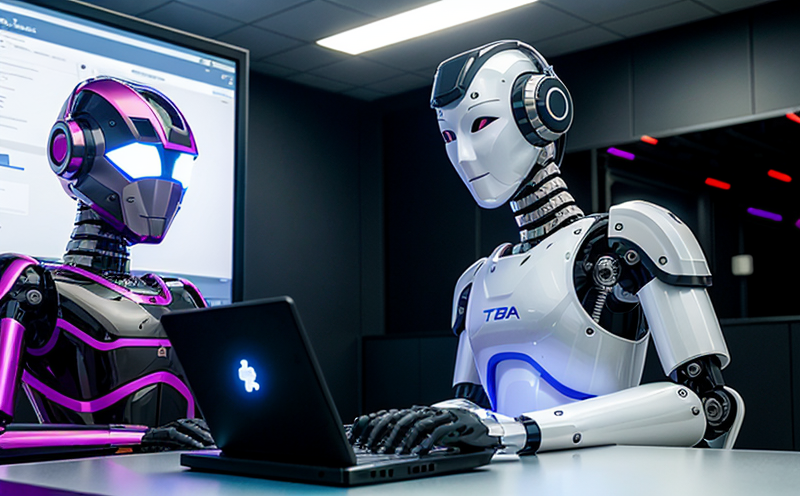UL 2900-2-3 Cybersecurity Evaluation for Autonomous Robots
The UL 2900-2-3 standard is a critical framework designed to evaluate cybersecurity risks in autonomous robots. This service ensures that robotics and AI systems are secure against cyber threats, which can have significant implications on safety, privacy, and operational integrity. As the world of robotics continues to expand into various sectors such as healthcare, manufacturing, agriculture, and transportation, the need for robust security measures cannot be overstated.
The standard focuses on assessing vulnerabilities in communication protocols, software components, firmware updates, and other critical elements that could potentially compromise data integrity or system functionality. It aims to protect against unauthorized access, data breaches, and malicious activities that could disrupt operations or cause harm.
For quality managers and compliance officers, this service provides a clear roadmap for meeting regulatory requirements while also enhancing the reputation of their organizations through transparent security practices. R&D engineers can leverage these evaluations to identify potential weaknesses early in the design phase, allowing for more resilient systems from the outset.
In the context of procurement, selecting suppliers who adhere to such rigorous testing protocols demonstrates commitment to high standards and fosters trust within supply chains. By ensuring that every aspect of a robot’s lifecycle—from initial development through end-of-life disposal—is handled securely, companies can minimize risks associated with cyber attacks.
- Data encryption methods
- Access control measures
- Secure communication channels
- Firmware verification procedures
The UL 2900-2-3 standard plays a pivotal role in safeguarding autonomous robots against evolving cyber threats. It offers a structured approach to identifying, mitigating, and monitoring risks throughout the product lifecycle.
By adhering to this standard, manufacturers can demonstrate their dedication to maintaining trustworthiness among consumers and regulatory bodies alike. This not only bolsters brand image but also contributes positively towards fostering an environment conducive for innovation across industries reliant upon advanced robotics technology.
Scope and Methodology
The scope of UL 2900-2-3 covers a comprehensive evaluation of cybersecurity risks in autonomous robots. This includes assessing the security posture of various components, including hardware, software, firmware, and communication protocols used within these systems.
Methodologically speaking, this involves several key steps:
- Initial Assessment: Identification of potential threats based on industry best practices and historical data.
- Vulnerability Analysis: Detailed examination of identified vulnerabilities to determine their impact on system integrity.
- Risk Mitigation Strategies: Development and implementation of strategies aimed at reducing identified risks without compromising functionality or performance.
- Continuous Monitoring: Ongoing evaluation of the system’s security posture to ensure ongoing compliance with best practices.
The methodology employed ensures that every facet of a robot's cybersecurity is thoroughly examined, providing assurance that no critical areas are overlooked during evaluation.
This systematic approach allows for a holistic understanding of potential risks and enables proactive measures to be taken before any issues arise. The end goal is to create autonomous robots that are not only reliable but also secure against modern cyber threats.
Quality and Reliability Assurance
- Data Encryption: Ensuring all data transmitted between components or stored within the robot is encrypted using industry-standard methods to prevent unauthorized access.
- Access Control: Implementing strict authentication protocols to ensure only authorized personnel can make changes to the system configuration or firmware updates.
- Secure Communication Channels: Utilizing secure communication channels such as TLS/SSL for data transmission between different parts of the robot and external networks.
- Firmware Verification Procedures: Regularly verifying the integrity of embedded software to ensure it has not been tampered with during manufacturing or over-the-air updates.
These rigorous quality assurance measures are essential in maintaining reliability and trustworthiness in autonomous robots. By adhering strictly to these guidelines, we can provide clients with peace-of-mind knowing that their systems meet the highest standards of cybersecurity.
The UL 2900-2-3 standard plays a crucial role in ensuring that all aspects of a robot’s security are addressed comprehensively and effectively. This includes not only protecting against external threats but also safeguarding internal processes from malicious activities.
International Acceptance and Recognition
The UL 2900-2-3 standard is widely recognized across the globe for its robust approach to cybersecurity in autonomous robots. Many countries have adopted this standard as a benchmark for evaluating the security of their own robotic systems.
- United States: The U.S. Department of Homeland Security (DHS) and National Institute of Standards and Technology (NIST) recommend adherence to UL standards for enhanced cybersecurity measures in robotics applications.
- European Union: Several EU directives, including the General Data Protection Regulation (GDPR), specifically mention compliance with international standards like UL when addressing data protection issues.
- Asia-Pacific Region: Countries such as Japan and South Korea have incorporated similar provisions into their national regulations to promote secure robotic technologies.
The widespread adoption of this standard reflects its significance in establishing a global consensus on cybersecurity standards for autonomous robots. By aligning with these international norms, manufacturers can ensure that their products meet the highest quality benchmarks while also complying with relevant local laws and regulations.
This recognition underscores the importance of implementing comprehensive cybersecurity measures early in the design process to prevent costly reworks later down the line. It also helps build confidence among stakeholders regarding product reliability and safety.





